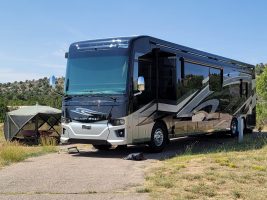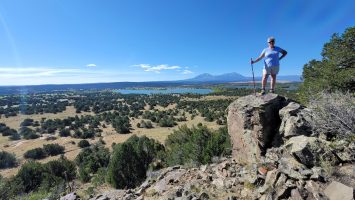Edit: We updated this post at the end of 2022 when we got a new modem/router.
It's a question we get a lot -- how does Monica work from the motor home? Monica has been working from motor homes for a few years, and there has been a lot of trial and error. We're sharing tips and tricks here, and hopefully it helps someone get to their solution a bit easier.
Workspace
One of the most important things to working from home is to have a good workspace. Some people can work on a bed with their laptop on their knees, but that isn't us. In a motor home like ours, it's not too difficult to have good technology.
- Good Computer: in some cases, you have to use the computer or laptop that is provided to you by your office. Monica uses her work laptop during the day. It's plugged in all the time to make sure it doesn't struggle, and it has a Jabra Speak 510+ hanging off a USB port that makes collaboration easier. It also has a Logitech keyboard and mouse, and a nice LG monitor to round it out. Her personal computer is a Lenovo ThinkStation P350 Tiny that is one of the best computers she's ever had (much better than a laptop).
- Decent Printer: most of the time, we don't print anything (there is nowhere to store what we print, and it's wasteful). When we do need to print or scan something, we have an HP Envy 6000 Series that is small enough to fit in a cupboard.
- File Storage: we use a lot of cloud storage, but we also have some local storage in external hard drives and a Synology DS220+ NAS. Cloud storage is great until you don't have solid Internet connectivity -- sometimes you need your files to be local.
- Power Management: we have a whole-house energy management system, and when we are plugged into shore power we don't need to worry about power fluctuations. But when we change power from shore to batteries to generator and back again, things get squirrely. We use APC UPS systems wherever we have sensitive equipment, and that keeps things steady.
- Backups: even the most careful of us lose files when bad things happen, so backups are vital. We back everything up to 10TB of storage space with IDrive.
Monica has to go into an office 20% of the year, and her technology takes a step down whenever she does. Working from an RV doesn't mean you have to sacrifice.
Internet Connectivity
Of course, you can only do so much without a connection to the Internet. It limits where we can stay during work hours, so we usually end up near towns and vacation destinations (you find the Internet in the strangest places). We count on reviews from RV Life to know what to expect before we ever make a reservation. If there is somewhere we want to stay that doesn't have connectivity, we save it for a weekend vacation.
People will usually greatly overestimate the upload and download speeds they need to get by. We've realized that anything over 20Mbps down and 5Mbps up is extra as we can work and play just fine with less. The important number is latency or ping, and we are always hoping to find something faster than 50 ms. If that number gets over 100ms you'll feel it no matter how good your speeds are.

It's good to understand, first, that the bars you see on your cellphone are just a pretty picture. In the end, they don't mean much. Instead, go to Speedtest and really test your speeds. Keep in mind that you can run multiple tests one after the other or throughout a day or week, and your results could fluctuate pretty wildly. But it's enough to give you a good idea.
Though some campgrounds provide Wi-Fi, it is rarely good enough. It is shared with the rest of the campground, and as a free service it is very rarely strong and stable. So, we don't count on that. Instead, we depend on cellular services. First, we make sure there is some cellular service where we are staying, and then we work on getting the best signal we can and keeping it strong.
| Hardware | Cellular |
| We use a Pepwave MAX BR2 Pro with the ability to use up to 7 WANs. We use two of the 5G cellular WANs with the two modems to combine them. We also have two Pepwave One AC Mini access points in a mesh network to extend our Wi-Fi and add wired options for some devices. A key addition was our Parsec Great Pyrenees 11-in-1 antenna mounted on the roof. It pulls in signal well, and works much better than other antennas and booster options we've tried in the past. | We use both AT&T and T-Mobile services. The Peplink router combines them, and we see better speedtest numbers with them both on than we do with them separately. They are both providing unlimited, high-speed, 5G Internet from MVNOs (not directly from the companies). We have a Verizon data plan we can use for emergencies. They run us $275 each month, but it's worth it for stable Internet. In addition, we use the SpeedFusion Cloud from Peplink for some of our applications and services like Microsoft Teams and Office 365 to make sure they have a dedicated path that they don't have to share with the other devices on our network. |
Though this post has largely been about Monica working, we use the Internet all day for play, too. Of course, we're on our Wi-Fi and hardwired network with cell phones, tablets, and laptops. We also use it for the four Google Nest Hubs we have, and the Google Nest Protect smoke alarms throughout the coach. At night, we're streaming movies while our neighbors are struggling with cell phone hotspots and campground Wi-Fi signals. It's expensive and a bit complicated, but worth it!
Any questions or comments? We're always happy to kick around ideas. Please leave a comment in the box below or contact us directly. As always, thanks for reading.



Leave a Reply